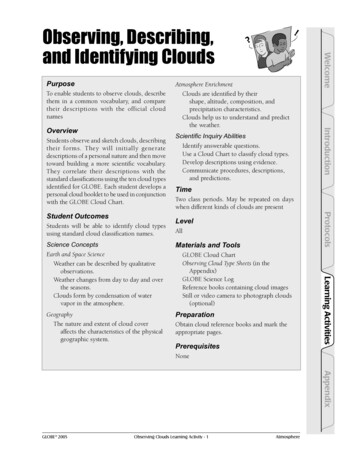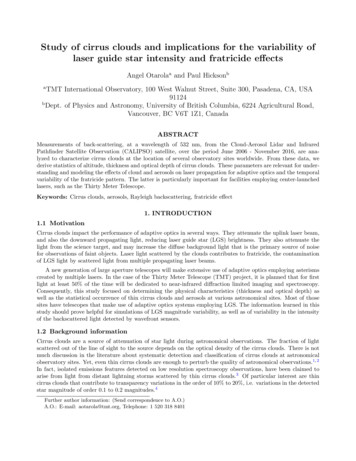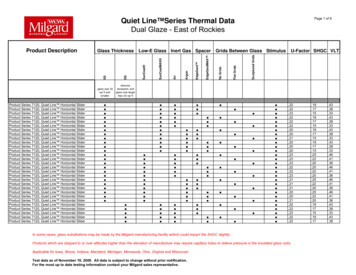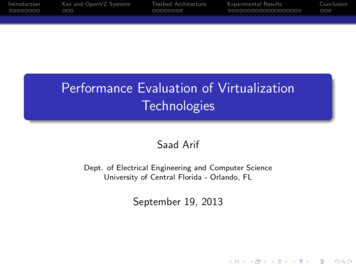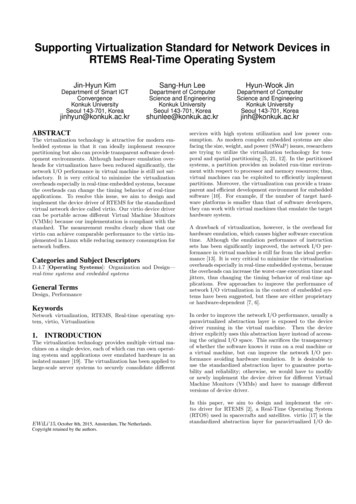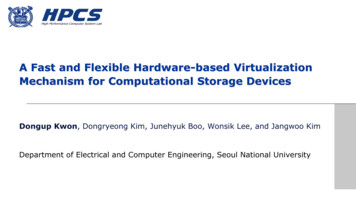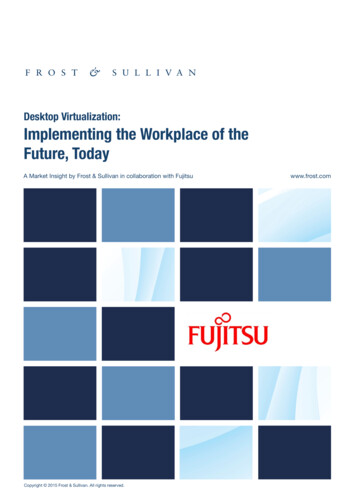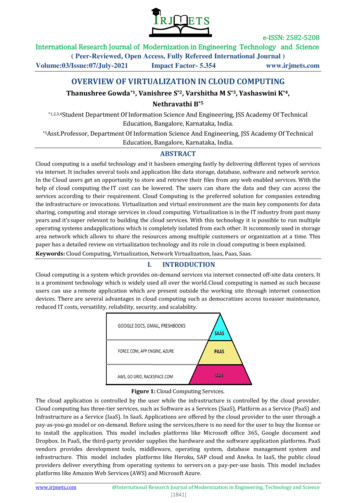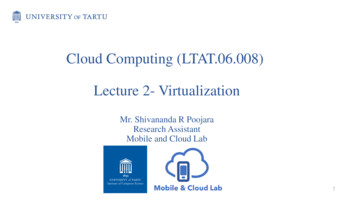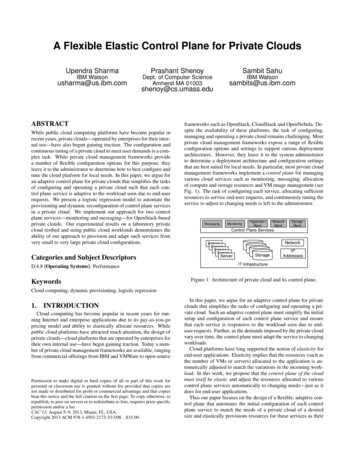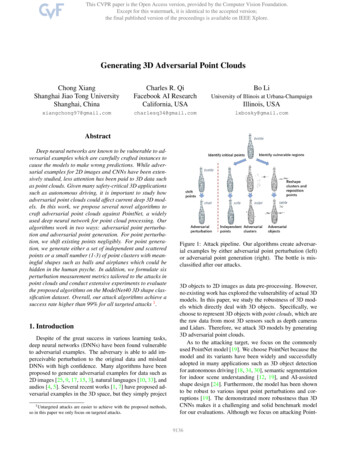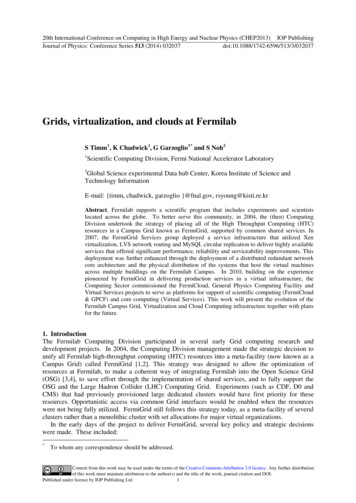
Transcription
20th International Conference on Computing in High Energy and Nuclear Physics (CHEP2013) IOP PublishingJournal of Physics: Conference Series 513 (2014) 032037doi:10.1088/1742-6596/513/3/032037Grids, virtualization, and clouds at FermilabS Timm1, K Chadwick1, G Garzoglio 1* and S Noh21Scientific Computing Division, Fermi National Accelerator Laboratory2Global Science experimental Data hub Center, Korea Institute of Science andTechnology InformationE-mail: {timm, chadwick, garzoglio }@fnal.gov, rsyoung@kisti.re.krAbstract. Fermilab supports a scientific program that includes experiments and scientistslocated across the globe. To better serve this community, in 2004, the (then) ComputingDivision undertook the strategy of placing all of the High Throughput Computing (HTC)resources in a Campus Grid known as FermiGrid, supported by common shared services. In2007, the FermiGrid Services group deployed a service infrastructure that utilized Xenvirtualization, LVS network routing and MySQL circular replication to deliver highly availableservices that offered significant performance, reliability and serviceability improvements. Thisdeployment was further enhanced through the deployment of a distributed redundant networkcore architecture and the physical distribution of the systems that host the virtual machinesacross multiple buildings on the Fermilab Campus. In 2010, building on the experiencepioneered by FermiGrid in delivering production services in a virtual infrastructure, theComputing Sector commissioned the FermiCloud, General Physics Computing Facility andVirtual Services projects to serve as platforms for support of scientific computing (FermiCloud& GPCF) and core computing (Virtual Services). This work will present the evolution of theFermilab Campus Grid, Virtualization and Cloud Computing infrastructure together with plansfor the future.1. IntroductionThe Fermilab Computing Division participated in several early Grid computing research anddevelopment projects. In 2004, the Computing Division management made the strategic decision tounify all Fermilab high-throughput computing (HTC) resources into a meta-facility (now known as aCampus Grid) called FermiGrid [1,2]. This strategy was designed to allow the optimization ofresources at Fermilab, to make a coherent way of integrating Fermilab into the Open Science Grid(OSG) [3,4], to save effort through the implementation of shared services, and to fully support theOSG and the Large Hadron Collider (LHC) Computing Grid. Experiments (such as CDF, D0 andCMS) that had previously provisioned large dedicated clusters would have first priority for theseresources. Opportunistic access via common Grid interfaces would be enabled when the resourceswere not being fully utilized. FermiGrid still follows this strategy today, as a meta-facility of severalclusters rather than a monolithic cluster with set allocations for major virtual organizations.In the early days of the project to deliver FermiGrid, several key policy and strategic decisionswere made. These included:*To whom any correspondence should be addressed.Content from this work may be used under the terms of the Creative Commons Attribution 3.0 licence. Any further distributionof this work must maintain attribution to the author(s) and the title of the work, journal citation and DOI.Published under licence by IOP Publishing Ltd1
20th International Conference on Computing in High Energy and Nuclear Physics (CHEP2013) IOP PublishingJournal of Physics: Conference Series 513 (2014) 032037doi:10.1088/1742-6596/513/3/032037 The development of security policies for the Open Science Enclave (later renamed to the OpenScience Environment) that addressed required system management configurations; The development of a site wide gateway that automatically routed Grid jobs from variouscommunities, such as the OSG, to clusters within the Campus Grid; A program of work that established interoperation for our major stakeholders and CampusGrid clusters that ensured that it was possible for all major stakeholders to run jobs on all ofthe Campus Grid clusters; The incorporation of a unified Grid credential to Unix UID mapping service across all theGrid clusters together with a central credential banning service; The decision to ensure that support for a minimum of two batch systems was maintained(currently HTCondor and Torque/PBS).In addition, Fermilab has deployed a Short Lived Credential Service (SLCS) Kerberos CertificateAuthority (KCA) that supports automatic generation of short-lived X.509 credentials derived fromKerberos 5 credentials. Each of these decisions will be discussed in detail below.2. The Open Science EnvironmentThe strategy that led to the development of the Open Science Environment was to separate thefunction of computational resources that run arbitrary jobs from external grid sources (Open ScienceEnvironment) from the functions of interactive login (General Computing Environment). This is doneby severely limiting interactive logins on the nodes, making sure that home directories are not shared,and that those application and data areas that are shared are not executable on any interactive node.Grid jobs execute in different accounts that do not have shells and thus can’t be logged into. Thislimits the ability of grid jobs to put arbitrary executables or modify user startup scripts in areas whereusers can log in. We require professional system management and prompt application of all securitypatches. The authorization servers for the Open Science Enclave are in locked racks in a card-accessrestricted computer room.3. Single site gateway and interoperabilityAt the present time, FermiGrid has twelve Compute Elements (CEs) that serve seven different Gridclusters (CMS, CDF, D0 x 4, and General Purpose). The majority of these CEs are not directlyaccessible outside of the Fermilab site. A single site gateway serves as an intermediary, accepting jobsfrom external OSG VOs as well as many on-site submitters who have chosen to run opportunisticallyacross FermiGrid. From each of the individual Grid clusters, the site gateway receives informationsuch as memory, disk, operating system version, number of jobs in execution or waiting and howmany free resources are available for each Virtual Organization (VO). This information is transferredvia the CEMon utility in the form of HTCondor classads and collected by the Resource SelectionService (ReSS) [5] Information Gatherer. The site gateway determines the potential candidate clusterto forward jobs to using HTCondor-G matchmaking, finding the cluster with free nodes that match thepublished job requirements.If a matched job does not start on the selected cluster within two hours, it is rescheduled on adifferent cluster where free slots are likely to be available. Most of the major users have configuredtheir jobs to be able to run on any FermiGrid cluster. When VO members are scheduled on their"home" cluster, they are not subject to preemption. Opportunistic jobs can be preempted if theprimary user needs the resources. The opportunistic jobs, however, are given 24 hours to completetheir processing when the preemption signal is given to the job.4. Overlay batch systemPrior to widespread grid deployment, users were accustomed to submitting jobs to a local cluster. Theidea of glideins using Condor through the system known first as glideCAF and later as glideinWMSallowed us to aggregate resources from across the complicated site into a single pool. All of thecertificate authorization was generated automatically on the users’ behalf, using automatically2
20th International Conference on Computing in High Energy and Nuclear Physics (CHEP2013) IOP PublishingJournal of Physics: Conference Series 513 (2014) 032037doi:10.1088/1742-6596/513/3/032037generated (Robot) X.509 credentials from the Fermilab KCA. This was a key technology intransitioning from expert-based grid production use to transparent use of the grid by all users.5. Unified user mappings and central banning serverThe Grid User Mapping Service (GUMS) is designed to assign privileges to the user from her VirtualOrganization, Group and Role. This information is encapsulated in the extended user credentials in theDistinguished Name and Fully Qualified Attribute Name (FQAN). GUMS is called by all resourcegateways for compute elements, worker nodes, and dCache-based storage elements. The callingmachine sends a message in XACML format, based on an agreed interoperability profile [6,9,10].Some virtual organizations request to have pool accounts, in which each user’s Distinguished Name ismapped to an individual username. Others are mapped to group accounts in which all members of avirtual organization run as the same username.The Site AuthoriZation (SAZ) service returns a simple Permitted/Denied response. It allows oursite to veto any grid identity based on Distinguished Name, Certificate Authority, VO, Role, orcertificate serial number. It uses the same XACML-based messaging format to receive its informationand is also called both from compute elements and from worker nodes. The ability to ban single usersimmediately during incident response investigation, rather than waiting for certificate revocations topropagate through the grid, is key to fast and effective incident response and is also used to quicklyterminate jobs which are putting undue load on the batch and storage resources.6. Virtualization and high availabilityThe FermiGrid central authentication services serve a number of different stakeholders, all of whichhave different and potentially incompatible scheduled maintenance windows. If central services suchas these are unavailable, no jobs can start or stop. Our service level agreement specified a 99.9%uptime and we designed for 99.999%. We also had to design for the potential of 5000 or moresimultaneous clients all trying to contact the server at once. Yet most of the time these central servicesrequired fairly small resources in terms of CPU, memory, and disk space under normal conditions, andcould not co-exist within the same operating system image because they all wanted to run on some ofthe same ports. We turned to virtual machines and high availability to address these problems.By using Xen for virtualization, we were able to transition the VOMS, GUMS, and SAZ services,which previously had run on three separate machines, to virtual machines on a single server. All threeof these services hold all state in a MySQL database so we made a fourth virtual machine to be acommon database backend for all three services. We then made a second server also with copies ofthese four virtual machines. In the initial days of Xen we needed to use a custom-built Xen kernel, butsupport was later added into Scientific Linux 5.We use Linux Virtual Server (as distributed in the Piranha package of Scientific Linux) to serve thepublic facing service IP’s and then directly route the traffic to one or both of the two virtual machinesbased on a weighted-least-connections algorithm. This allowed us to have an active/activeconfiguration, using both copies of the service when both were available and failing all the traffic toone when the other was down. The Linux Virtual Server itself has a backup that is supported byheartbeat. The FermiGrid-HA configuration went live in late 2007 and has delivered better than 99.9%service availability from that time until now.We later added the Squid web proxy service and MyProxy to the high-availability services wesupport. MyProxy stores its state in a file system. We replicate this using the DRBD file system andcontrol the service using Heartbeat. The Gratia Accounting services that we operate for the Fermilabsite and for the Open Science Grid also are in a partial high availability configuration, in which thereis always a web server and database available for reporting resource usage, using one-way MySQLreplication.In 2011, after a series of electrical and network failures, we divided the two halves of the servicesbetween two different buildings at Fermilab in the FermiGrid-HA2 project. The network topology hasalso been changed such that even if we lose one of the two buildings we can still get network3
20th International Conference on Computing in High Energy and Nuclear Physics (CHEP2013) IOP PublishingJournal of Physics: Conference Series 513 (2014) 032037doi:10.1088/1742-6596/513/3/032037switching and routing. This configuration successfully worked hours after deployment due to abuilding failure and has worked several times since that. The flexibility in doing upgrades and routinemaintenance that this service structure affords is key to high reliability over the long term.7. Virtualization and cloud at FermilabAfter several years of successful operation of high-availability static virtualization in FermiGrid andelsewhere on site, the Computing Division launched three new virtualization projects in 2010. Anenterprise-class VMWare virtualization infrastructure was set up with its focus on the core IT services.The General Physics Computing Facility was set up to provide static virtualization for long-livedscientific stakeholder application such as interactive login, local batch submission, and other auxiliaryservices. The FermiCloud project was launched to investigate cloud technologies and establish an ondemand Infrastructure as a Service facility for scientific stakeholders. This includes the developers,integrators, and testers who build and operate grid middleware systems for scientific stakeholders,who have a large need for a test facility. We anticipated that the various projects would eventuallyshare technology solutions and interoperate.The FermiCloud project has consisted of four phases to date. In the first phase we collected therequirements, bought the hardware, and selected the OpenNebula open-source cloud managementsoftware stack. In the second phase we deployed a variety of virtual machines for scientificstakeholders and did systematic testing on real applications in virtualized hardware, including variousopen-source distributed storage applications [7,8], MPI over virtualized Infiniband, and networkingperformance. We also added X.509 authentication and secure contextualization. The third phaseincluded expanding the cloud to two buildings linked by a replicated SAN-based file system. We alsoadded accounting, automated configuration via puppet, and monitoring mechanisms. In the fourthphase during the summer of 2013, we completed a joint Cooperative Research and DevelopmentAgreement with the Korean Institute of Supercomputing and Technology Information (KISTI) inwhich we leveraged all these technologies to run workflows of real scientific users on a distributedcloud.8. Grid technologies on the cloudThe key contributions of the FermiCloud project to cloud computing stem from our successfulexperience with grids and virtualization. In broad terms, these include security authentication,security policy, accounting, virtualization and high availability. We were able to leverage existing gridauthentication and authorization services in the cloud. We use automatically generated certificatesfrom our Kerberos Certificate Authority to use X.509 authentication, code that we contributed back tothe core OpenNebula software. We used existing software modules of the AuthorizationInteroperability profile to contact our existing GUMS and SAZ services for cloud authorization.FermiCloud differs from most other private clouds at national laboratories in that it is on the mainsite network with access to all resources both on and off site. Given the extensive experience indefining the security policies and controls for the Open Science Environment, we were able to predictsome key security policy issues. We developed a secure contextualization process such that nopersistent secrets, such as X.509 personal and host certificates or Kerberos 5 credentials, are stored inthe image repository. They are loaded at launch time of the virtual machine and stored in a RAM diskso that they don’t persist after the machine shutdown/reboot. We are working on a special securityscanner for inbound virtual machine images that will scan them before providing access to the publicnetwork. Again permissions on shared network file systems are important, particularly since theinfrastructure-as-a-service users have root access on their virtual machines.We were able to reuse most of our Gratia accounting system for the grid to do user accounting forthe cloud. After we wrote a new probe to interpret OpenNebula virtual machine records, the systemnaturally provided collection, reporting, and display. We also leverage the Nagios and RSV systems,typically used to monitor grid services, for monitoring essential services on the cloud, using availableNagios plugins for the cloud software.4
20th International Conference on Computing in High Energy and Nuclear Physics (CHEP2013) IOP PublishingJournal of Physics: Conference Series 513 (2014) 032037doi:10.1088/1742-6596/513/3/032037The auxiliary services that help us run FermiCloud, such as puppet, cobbler, mysql, LVS,webservers, NIS servers, Nagios, and the secure secrets repository, are all themselves on virtualmachines. We have plans to make the OpenNebula head node itself a virtual machine. We have useda variety of high availability tactics to keep the OpenNebula service up. We started with Heartbeatand DRBD/GFS2 in an active/active mode to control the OpenNebula service and the file repository.We have now moved the image repository to our replicated SAN and are using Clustered LVM(CLVM) and GFS2 for the file system that is shared between all nodes. The shared SAN-based filesystem allows for live migration of virtual machines and faster launching. The rgmanager function ofthe Red Hat clustering system is used to make sure that the OpenNebula service is running on one ofthe two identically configured head nodes.9. Highlights of recent workIn the joint Cooperative Research and Development Agreement with KISTI recently completed thissummer, we worked on three major activities, all geared toward enabling scientific workflows to runon federated clouds.The Virtual Infrastructure Automation and Provisioning program was organized in three thrusts.First, we tested that the GlideinWMS system could directly submit pilot jobs as virtual machines toboth FermiCloud and Amazon EC2. Second, we presented our cloud resources through a local gridgatekeeper; regular jobs received are locally queued and, through the vcluster system, virtual machinesare provisioned at FermiCloud, KISTI’s Gcloud, and Amazon EC2. Third, we commissioned a systemto periodically check whether virtual machines on FermiCloud are idle and, in case, suspend them toreclaim the computing slot. All of these technology tests were successful and are on their way tobeing made part of our production cloud and job submission infrastructure. We used the GlideinWMSsetup to submit a significant fraction of the NOvA experimental cosmic ray simulation to FermiCloudat the scale of 50-75 simultaneous virtual machines. The virtual machine submitted via glideinWMS isa bare-bones virtual machine, with the user applications delivered via the CernVM-FS (CVMFS)system.Interoperability and Federation of Cloud Resources task investigated and documented differencesbetween various clouds in the format of their virtual machine images and in the way in which theyemulate the Amazon EC2 web services API. This produced a large document complete with examplesand instructions for users [11].High-Throughput Fabric Virtualization was a program of work to continue and repeat the earlierwork we had done with virtualized high-speed Ethernet and Infiniband. We successfully repeated ourearlier results with MPI applications over virtualized Infiniband. We have now added options to ourproduction OpenNebula cluster so that a user can request machines with a virtual Infiniband interface.10. Future plansFermilab is and has been a strong catalyst for scientific computing for multi-domain science and, inparticular, for HEP at all the frontiers. As we move into the future, the infrastructure is shaped by thechanging and increasing needs of our physics communities, from the collider experiments of theEnergy Frontier to the more diverse world of Intensity and Cosmic Frontier. We are moving from theneed of federating our campus for a few large collaborations, to supporting many smallercollaborations in addition to a few big ones (CMS, LSST 2018, etc.). This implies a push fromstatically allocated virtualization to a dynamic one (cloud) i.e. from statically allocated services to ondemand ones; from four large clusters to possibly two larger ones.We are moving from being a large provider of opportunistic cycles to becoming a large user ofthose on the OSG; from relying on resources federated across academic institutions to includingcommercial ones to address coincident peak needs of our grown community. This means that we needto aid many user communities, which have run only on-site, in getting their applications to work onexternal grids and clouds. We will also re-examine our campus grid federation mechanism based onthe new technologies, such as glideinWMS, that have become available since we originally deployed it5
20th International Conference on Computing in High Energy and Nuclear Physics (CHEP2013) IOP PublishingJournal of Physics: Conference Series 513 (2014) 032037doi:10.1088/1742-6596/513/3/032037in 2005. Various new methods of authentication and authorization are also proliferating in thescientific computing world and we will have to be flexible to support those as well as the traditionalX.509 based methods of authentication.In addition to the number and size of the stakeholders changing, also the nature of the workload ischanging, with bigger data sets that are not easily split in smaller sets. Some jobs require large scratchspace; others require more memory than usual or multiple CPU’s. The work tends to come in burstsrather than a steady rate. We also support legacy experiments with old versions of operating systemsand applications that may require software-defined networking to contact mass storage services anddatabases. All of this means that we will need to use a variety of facilities in both grid and cloud andmake their configuration and provisioning more flexible.The next phase of the FermiCloud project will focus on increasing the scale of the federated cloudscience workflows to 1000 or more virtual machines. We will look at provisioning algorithms,focusing on when to extend to commercial clouds, including allocations for spot pricing, and how tooptimally shift workflow execution locations based on resource availability. We will also focus ondata movement services to and from the cloud and how to scale their capacity based on demand.11. ConclusionThe careful service and policy design at the beginning of FermiGrid has served us well through thegrid era and well into the cloud era. Our efforts to date have resulted in a much better utilization ofour on-site resources and high availability and reliability of our central services. We now havedemonstrated a clear path to enable smaller stakeholders to make use of resources on the Open ScienceGrid, FermiCloud, and commercial clouds. Our focus going forward is to continue to optimize thatexperience for our scientific stakeholders.AcknowledgementsWork supported by the U.S. Department of Energy under contract No. DE-AC02-07CH11359, and byCRADA FRA 2013-0001 / KISTI-C13013.References[1] K. Chadwick, E. Berman, P. Canal, T. Hesselroth, G. Garzoglio, T. Levshina, V. Sergeev et al."FermiGrid — Experience and future plans." In Journal of Physics: Conference Series, vol.119, no. 5, p. 052010. IOP Publishing, 2008.[2] V. Sergeev, I. Sfiligoi, N. Sharma, S. Timm., DR Yocum, E. Berman, P. Canal, K. Chadwick,T. Hesselroth, G. Garzoglio, and T. Levshina, "FermiGrid" In proceedings of TeraGrid2007, Madison, WI (2007).[3] Pordes, R. et al. (2007). "The Open Science Grid", J. Phys. Conf. Ser. 78,012057.doi:10.1088/1742-6596/78/1/012057.[4] Sfiligoi, I., Bradley, D. C., Holzman, B., Mhashilkar, P., Padhi, S. and Wurthwein, F. (2009)."The Pilot Way to Grid Resources Using glideinWMS", 2009 WRI World Congress onComputer Science and Information Engineering, Vol. 2, pp. 428–432.doi:10.1109/CSIE.2009.950.[5] P. Mhashilkar, G. Garzoglio, T. Levshina, and S. Timm. "ReSS: Resource Selection Service forNational and Campus Grid Infrastructure." In Journal of Physics: Conference Series, vol.219, no. 6, p. 062059. IOP Publishing, 2010.[6] G. Garzoglio, J. Bester, K. Chadwick, D. Dykstra, D. Groep, J. Gu, T. Hesselroth et al."Adoption of a SAML-XACML Profile for Authorization Interoperability across GridMiddleware in OSG and EGEE." In Journal of Physics: Conference Series, vol. 331, no. 6, p.062011. IOP Publishing, 2011.[7] G. Garzoglio, K. Chadwick, T. Hesselroth, A. Norman, D. Perevalov, D. Strain, and S. Timm."Investigation of storage options for scientific computing on Grid and Cloud facilities." InInternational Symposium on Grids and Clouds and the Open Grid Forum, vol. 1, p. 47. 2011.6
20th International Conference on Computing in High Energy and Nuclear Physics (CHEP2013) IOP PublishingJournal of Physics: Conference Series 513 (2014) 032037doi:10.1088/1742-6596/513/3/032037[8]G. Garzoglio. "Investigation of Storage Options for Scientific Computing on Grid and CloudFacilities." In Journal of Physics: Conference Series, vol. 396, no. 4, p. 042021. IOPPublishing, 2012.[9] R. Ananthakrishnan, G. Garzoglio, O. Koeroo, "An XACML Attribute and Obligation Profilefor Authorization Interoperability in Grids", Open Grid Forum GFD.205 (2012)[10] G. Garzoglio et al., "Definition and Implementation of a SAML-XACML Profile forAuthorization Interoperability across Grid Middleware in OSG and EGEE", Published in theJournal of Grid Computing, Vol. 7, Issue 3 (2009), Page 297, DOI 10.1007/s10723-0099117-4[11] Virtual machine interoperability wDocument?docid 52087
The Fermilab Computing Division participated in several early Grid computing research and development projects. In 2004, the Computing Division management made the strategic decision to unify all Fermilab high-throughput computing (HTC) resources into a meta-facility (now known as a Campus Grid) called FermiGrid ,2].
